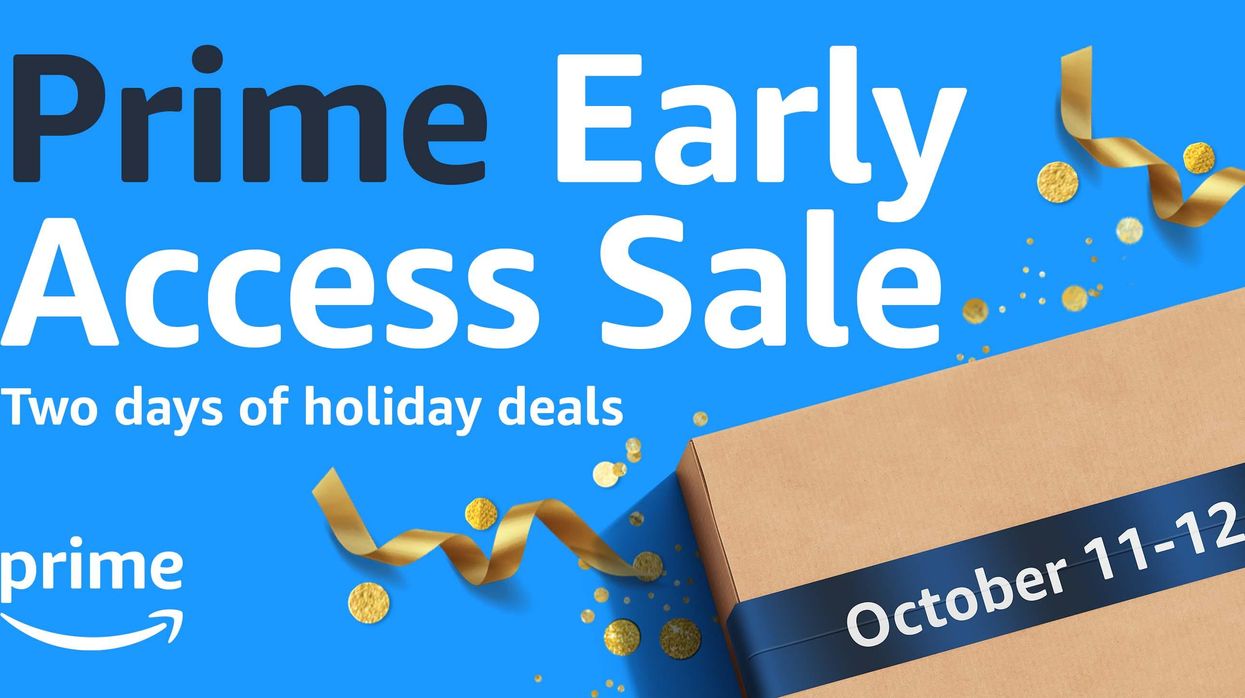Retail Channels
26 September 2022
Amazon drops details on fall deals event: Prime Early Access Sale
The 48-hour event is set for Oct. 11-12. Holiday shopping is starting in October this year.

Amazon Prime Early Access is set. (Image via Amazon)
The 48-hour event is set for Oct. 11-12. Holiday shopping is starting in October this year.

Amazon Prime Early Access is set. (Image via Amazon)
After a summer of speculation, Amazon on Monday announced a new fall deals event for Prime subscribers.
Prime Early Access Sale is set to take place Oct. 11-12 across 15 countries. The event is being positioned as a kickoff to the holiday season, giving Prime members "exclusive" access to advance deals on items as shoppers search for gifts for others, and items for themselves.
An Amazon announcement said it is offering deals on “Peloton [which wasn’t available on Amazon until recently] and New Balance, and Amazon’s lowest prices of the year on select products from brands like Caudalie, Murad, and Philips Sonicare.”
Along with the deals event, Amazon said it will also debut a curated Top 100 list of its “most popular and giftable items” for the season, including products from Hasbro, iRobot, KitchenAid, and Samsung. Deals from this list will drop throughout the event across categories including electronics, fashion, home, kitchen, pets, toys and Amazon devices, Amazon said.
Amazon is also offering up to 80% off select Fire TV smart TVs, and additional savings on Alexa-enabled devices and products from LEGO, adidas, Furbo and Ashley Furniture.
“We are so excited to help Prime members kick off the holiday season with Amazon’s new Prime Early Access Sale—an exclusive opportunity for members to get deep discounts on top brands we know they are looking for this time of year,” said Jamil Ghani, VP of Amazon Prime in a statement.
The countdown is on: Prime Early Access Sales begins at 12 a.m. Pacific time on Oct. 11 in Austria, Canada, China, France, Germany, Italy, Luxembourg, the Netherlands, Poland, Portugal, Spain, Sweden, Turkey, the UK, and the US.
Here are a few takeaways on Monday’s announcement:
Prime Day, part 2: The two-day deals event adds another big sale to Amazon’s calendar alongside Prime Day, which is held in the summer. Amazon had reportedly been planning a “fall deals event” for months. Monday's news release did not detail involvement of deals from third-party sellers in the event, but a recent report from Digital Commerce 360 indicated that Amazon has been reaching out to sellers and sharing inventory shipment deadlines.
Pre-Black Friday: When it comes to holiday shopping, pre-Halloween is the new post-Thanksgiving. Holiday shopping has been shifting earlier and earlier in recent years. While last year’s supply chain challenges prompted many to factor delays into their gifting plans, this year is bringing more formal deal events that shift the calendar well ahead of Black Friday and Cyber Monday. Alongside Prime Early Access Sales, Target announced last week that it will run an early holiday edition of its Deal Days event on Oct. 6-8. This spreads out the calendar for the busy shopping season, offering more options for shoppers rather than concentrating all activity on a single rush.
Signup sweeteners: While holidays are the theme of Amazon’s deal event, the tactics are oriented around Amazon Prime in a similar fashion to Prime Day. To entice signups to the subscription ecommerce service that offers free delivery and returns, Amazon is rolling out promotions including four free months of Amazon Music Unlimited and a free year of Grubhub+ membership. Amazon is effectively saying that access to deals is one benefit of a Prime membership, while detailing other perks that go beyond shopping. Media is an increasingly important part of Prime. Earlier this month, Amazon Prime Video's season debut of Thursday Night Football drew a record number of Prime signups for a three-hour period, CNBC reported.
Halo effect? One question going into Prime Early Access: Will a fall event create a new rising tide that lifts all of retail? One of the things that makes Prime Day significant is its “halo effect,” which describes how other retailers get a boost from customers seeking deals. For the summer event, this has led others to time their own savings promotions around Amazon, though Walmart famously opted out of a Prime Day event this year in favor of its own Walmart+ event a month earlier. For the holiday event, Target isn’t timing its event with Prime. Walmart last week rolled out a host of new holiday initiatives, saying it is investing in price discounts, expanding its assortment, offering curbside dropoff and home pickup of returns and making upgrades to its app. While all of the retailers are making big early holiday pushes, it’s not as clear in this case that they are orienting around Amazon. Rather, they are making individual pushes that together could move the start of the holiday season to October.Year of deals: In the frenzy to prep for this year, keep this in mind for next: It's not yet clear whether Prime Early Access Sale will be a permanent addition to the Amazon calendar. Deals are expected to be especially important to consumers this year as they shop at a time of 40-year-high inflation, and retailers are responding in kind. An Index Analytics analysis found Prime Day discounts in 2022 were twice as deep as 2019-2021. At the same time, many retailers are seeking to move excess inventory that resulted from demand changes amid the return to in-person events. It remains to be seen whether Amazon is capitalizing on a specific opportunity in 2022, or creating a new tentpole for years to come.
Amazon partnered with Hexa to provide access to a platform that creates lifelike digital images.
A 3D rendering of a toaster from Hexa and Amazon. (Courtesy photo)
Amazon sellers will be able to offer a variety of 3D visualizations on product pages through a new set of immersive tools that are debuting on Tuesday.
Through an expanded partnership with Hexa, Amazon is providing access to a workflow that allows sellers to create 3D assets and display the following:
Selllers don't need prior experience with 3D or virtual reality to use the system, according to Hexa. Amazon selling partners can upload their Amazon Standard Identification Number (ASIN) into Hexa’s content management system. Then, the system will automatically convert an image into a 3D model with AR compatibility. Amazon can then animate the images with 360-degree viewing and augmented reality, which renders digital imagery over a physical space.
Hexa’s platform uses AI to create digital twins of physical objects, including consumer goods. Over the last 24 months, Hexa worked alongside the spatial computing team at Amazon Web Services (AWS) and the imaging team at Amazon.com to build the infrastructure that provides 3D assets for the thousands of sellers that work with Amazon.
“Working with Amazon has opened up a whole new distribution channel for our partners,” said Gavin Goodvach, Hexa’s Vice President of Partnerships.
Hexa’s platform is designed to create lifelike renderings that can explored in 3D, or overlaid into photos of the physical world. It allows assets from any category to be created, ranging from furniture to jewelry to apparel.

The result is a system that allows sellers to provide a new level of personalization, said Hexa CEO Yehiel Atias. Consumers will have new opportunity see a product in a space, or what it looks like on their person.
Additionally, merchants can leverage these tools to optimize the entire funnel of a purchase. Advanced imagery allows more people to view and engage with a product during the initial shopping experience. Following the purchase, consumers who have gotten a better look at a product from all angles will be more likely to have confidence that the product matches their needs. In turn, this can reduce return rates.
While Amazon has previously introduced virtual try-on and augmented reality tools, this partnership aims to expand these capabilities beyond the name brands that often have 1P relationships with Amazon. Third-party sellers are an increasingly formidable segment of Amazon’s business, as they account for 60% of sales on the marketplace. Now, these sellers are being equipped with tools that enhance the shopping experience for everyone.
A video displaying the new capabilities is below. Amazon sellers can learn more about the platform here.
Hexa & Amazon - 3D Production Powerhousewww.youtube.com